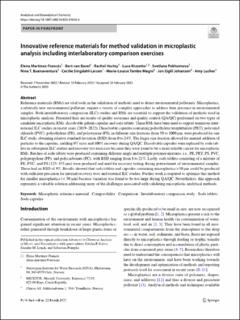Innovative reference materials for method validation in microplastic analysis including interlaboratory comparison exercises
Martínez Francés, Elena; van Bavel, Bert; Hurley, Rachel; Nizzetto, Luca; Pakhomova, Svetlana; Buenaventura, Nina Tuscano; Singdahl-Larsen, Cecilie; Magni, Marie-Louise Tambo; Johansen, Jon Eigill; Lusher, Amy Lorraine
Peer reviewed, Journal article
Published version
Permanent lenke
https://hdl.handle.net/11250/3063713Utgivelsesdato
2023Metadata
Vis full innførselSamlinger
- Publikasjoner fra Cristin - NIVA [2148]
- Scientific publications [1172]
Sammendrag
Reference materials (RMs) are vital tools in the validation of methods used to detect environmental pollutants. Microplastics, a relatively new environmental pollutant, require a variety of complex approaches to address their presence in environmental samples. Both interlaboratory comparison (ILC) studies and RMs are essential to support the validation of methods used in microplastic analysis. Presented here are results of quality assurance and quality control (QA/QC) performed on two types of candidate microplastic RMs: dissolvable gelatin capsules and soda tablets. These RMs have been used to support numerous international ILC studies in recent years (2019–2022). Dissolvable capsules containing polyethylene terephthalate (PET), polyvinyl chloride (PVC), polyethylene (PE), and polystyrene (PS), in different size fractions from 50 to 1000 µm, were produced for one ILC study, obtaining relative standard deviation (RSD) from 0 to 24%. The larger size fraction allowed for manual addition of particles to the capsules, yielding 0% error and 100% recovery during QA/QC. Dissolvable capsules were replaced by soda tablets in subsequent ILC studies and recovery test exercises because they were found to be a more reliable carrier for microplastic RMs. Batches of soda tablets were produced containing different single and multiple polymer mixtures, i.e., PE, PET, PS, PVC, polypropylene (PP), and polycarbonate (PC), with RSD ranging from 8 to 21%. Lastly, soda tablets consisting of a mixture of PE, PVC, and PS (125–355 µm) were produced and used for recovery testing during pretreatment of environmental samples. These had an RSD of 9%. Results showed that soda tablets and capsules containing microplastics >50 µm could be produced with sufficient precision for internal recovery tests and external ILC studies. Further work is required to optimize this method for smaller microplastics (< 50 µm) because variation was found to be too large during QA/QC. Nevertheless, this approach represents a valuable solution addressing many of the challenges associated with validating microplastic analytical methods.

